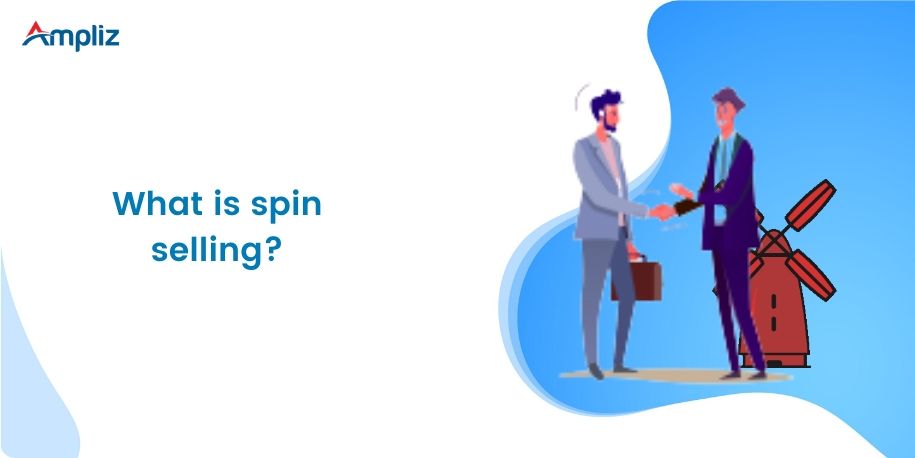In the sales and marketing domain, there are lots of advice and tips many experts have provided. Though those are useful for all sales and marketing people, the book “SPIN Selling” stands out in the crowd for its unique features.
Despite implementing all the strategies, most of the organizations fail to have successful sales. SPIN Selling methodology shapes their sales lives from zero to hero by providing real-time sales success.
What is SPIN selling?
“SPIN Selling”, a term that is not new to the sales experts who belong to the B2B industry. SPIN Selling is a sales technique that is described in the SPIN Selling book. It is written by Neil Rackham and was first published in 1988.
This book is a research-based book where Neil Rackham researched 35,000 sales calls over 12 years. The sales framework is built and published in this book after a plethora of researches and experiments.
According to Neil Rackham, sales reps should avoid the traditional way of approaching the customers. He has introduced different types of questions a sales rep should ask the customers in order to understand them and have successful sales.

SPIN selling questions that you should ask
SPIN Selling is a sales framework discovered and mentioned in the book “SPIN Selling”. Neil Rackham stressed on the questions that should be asked by the sales reps to the customers. After researching a plethora of sales calls, he found a conclusion that sales rep should listen more and talk less in order to understand the customers.
Instead of asking random questions, they should ask four types of questions to take the conversation from scratch to the end:
- S – Situation Questions
- P – Problem Questions
- I – Implication Questions
- N – Need-Payoff Questions
Situation Questions
Most of the sales reps are in a hurry to finish the call as they need to move to the next call. That is the reason they immediately pitch the product or service as soon as they connect with the prospects. Immediately, pitching the product or service is the wrong way to approach. As per the SPIN Selling technique, the call should start with the situation question questions.
The situation questions are asked to get the information from the customers to understand their situations. Ask those questions that will provide you with essential information. Avoid the questions from which you will not get valuable information.
Situation questions never replace background research. Though background research helps you understand customers, situation questions help to build rapport with the customers from the initial stage. By answering all the below questions, the customer will have trust that you understand the situation instead of being pushy for your product or service.
Questions
- How is your process going on?
- What product/service you are using now?
- Is it purchased or leased?
- Are you happy with the current service you are getting?
- Why did you prefer this service/product?
- Are you able to handle the day with the current services/products?
Problem Questions
As per Neil Rackham, “We want to discover how [the client] sees the problem,” “If the customer doesn’t feel they have a problem, they don’t have a problem.” The concept behind the problem questions is to identify the customers’ problems.
When your sales reps are speaking to them, definitely you have the solution to their problems. But let them (your client) realize the problem. That is the reason you need to ask the problem questions.
The situation questions help you find your customer’s situation but problem questions will provide you with brief ideas of the challenges your customers are facing.
According to the survey, 42% of salespeople mentioned that the biggest challenge for them is to identify the obstacles and the urgency of the solution. Hence, asking a few skillful questions, you can make them realize their obstacles and urgency of the solutions.
Here are a few examples of problem questions:
Questions
- How expensive your equipment is?
- Is it worth?
- How long it takes to fix the issue in the purchased equipment?
- How often do you face problems?
- If you fail to fix the issues in your equipment, what is the backup plan you follow?
- Are your team members comfortable using this tool?

Implication Questions
Once you identify the problems and you need to ask implication questions. The basic concept of the implication questions is to understand the depth of the problem and the urgency of having solutions. This is a very important step as prospects get motivated by understanding the seriousness of the consequences.
When your prospect is a decision-maker, each and every question is effective at this stage. These questions make your prospect realize the effect of the problems and how soon the solution is required to fix it. The urgency creation impacts a lot and helps to get a successful sale.
While situation questions give a picture of your customers’ situation and problem questions provide the idea of problems your customers are facing, implication questions directly jump to the consequences. The more skillful questions you will ask the more sales you will get.
Questions
- Are you able to handle the current problems?
- How much do you pay to fix the problems?
- How long does it take to fix the problems?
- Will you be able to control the consequences at this time if it takes time to fix the issue?
- Are your customers happy with this delay?
- Have you lost any project due to the current issue?
- Have you taken any preventive to avoid this bug?
- Did you lose brand loyalty due to these problems?
Need-Payoff Questions
The term “Need-Payoff” explains itself that this stage is to pay for prospects’ needs. After all the above steps and having all ideas about the obstacles and required solutions for the prospect, the well-crafted need-payoff questions lead to successful sales. The need-payoff questions are asked to highlight the solution that is needed to fix the problems. When your prospect feels the need for a solution, you need to exhibit your products or services.
The need-payoff questions are direct answers to the implication questions. These questions lead your prospects towards your product or service automatically instead of you speak about them voluntarily. These four types of questions are the chain to take the prospects towards the end result but need-payoff questions affect the sales directly.
The remarkable point is that don’t ask such questions for which your products doesn’t have a solution. Stress on those question which will provide you with valuable information.
Questions:
- Would it be helpful if you take ……..(your pro product or service)?
- Will your current situation be stable if you have the …..(describe the possible features that may help your prospects)?
- Do you think if you have other options like ….(provide the options that can be helpful for your prospects to deal with the current situations)?
- Will your team members happy if you bring user-friendly tools like …….?
- Do you think changing your current service or product can be more beneficial?
Now that we’ve covered Spin selling in detail, you should also check out these amazing sales techniques which will help you to scale your revenue.
The well-crafted questions compel the prospects to think twice about the current service and try a new service or product that is presented. The SPIN Selling has the researched-based scenarios where the author has observed several sales calls and analyzed those to discover this methodology. When your sales go down, try these questions and share your results with us.
Key Takeaways
What is the SPIN method of selling?
The SPIN method of selling is a form of sales technique that refers to 4 types of questions that a salesperson should ask its prospects. SPIN stands for Situation, Problem, Implications, and Need-Payoff.
Does SPIN selling still work?
This sales technique has been around for over 30 years now but is still widely used. It’s quite relevant even in 2020.
What is the point of SPIN selling?
SPIN selling is designed to equip sales reps with a series of questions that will help them to understand the prospect better. This technique smoothest out the sales process and promises more closed deals.




